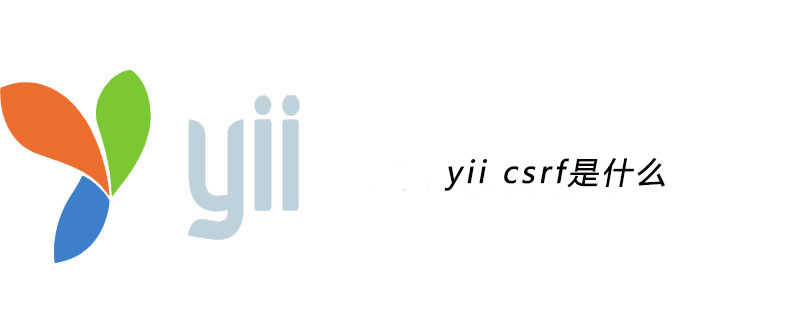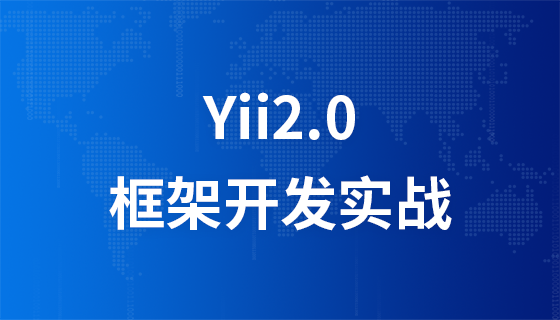跨站請求偽造(英文:Cross-site request forgery),也稱為 one-click attack 或 session riding,通常縮寫為 CSRF 或 XSRF, 是一種挾制用戶在目前已登入的網頁應用程式上執行非本意的操作的攻擊方法。

跨站請求攻擊,簡單地說,是攻擊者透過一些技術手段欺騙用戶的瀏覽器去訪問一個自己曾經認證過的網站並運行一些操作(如發郵件,發送訊息,甚至財產操作如轉帳和購買商品)。 (建議學習:yii架構)
由於瀏覽器曾經認證過,所以被造訪的網站會被認為是真正的使用者操作而去運作。
這利用了web中用戶身份驗證的漏洞:簡單的身份驗證只能保證請求發自某個用戶的瀏覽器,卻不能保證請求本身是用戶自願發出的。
yii2的csrf,這裡簡單介紹一下它的驗證機制。
取用於csrf驗證的token值;判斷用於csrf的token是否存在,如果不存在則使用generateCsrfToken()產生。
驗證web\Controller中的beforeAction()方法中有Yii::$app->getRequest()->validateCsrfToken()判斷,用來驗證csrf。
一般我的認識yii2的csrf都是從Yii::$app->request->getCsrfToken()開始;好的,我們就從getCsrfToken()說起。此方法在yii\web\Request.php:
/**
* Returns the token used to perform CSRF validation.
* 返回用于执行CSRF验证的token
* This token is a masked version of [[rawCsrfToken]] to prevent [BREACH attacks](http://breachattack.com/).
* This token may be passed along via a hidden field of an HTML form or an HTTP header value
* to support CSRF validation.
* @param boolean $regenerate whether to regenerate CSRF token. When this parameter is true, each time
* this method is called, a new CSRF token will be generated and persisted (in session or cookie).
* @return string the token used to perform CSRF validation.
*/
public function getCsrfToken($regenerate = false)
{
if ($this->_csrfToken === null || $regenerate) {
if ($regenerate || ($token = $this->loadCsrfToken()) === null) { //loadCsrfToken()就是在cookie或者session中获取token值
$token = $this->generateCsrfToken(); //如果token为空则调用generateCsrfToken()去生成
}
// the mask doesn't need to be very random
$chars = 'ABCDEFGHIJKLMNOPQRSTUVWXYZabcdefghijklmnopqrstuvwxyz0123456789_-.';
$mask = substr(str_shuffle(str_repeat($chars, 5)), 0, static::CSRF_MASK_LENGTH);
// The + sign may be decoded as blank space later, which will fail the validation
$this->_csrfToken = str_replace('+', '.', base64_encode($mask . $this->xorTokens($token, $mask)));
}
return $this->_csrfToken;
}
/**
* Loads the CSRF token from cookie or session.
* @return string the CSRF token loaded from cookie or session. Null is returned if the cookie or session
* does not have CSRF token.
*/
protected function loadCsrfToken()
{
if ($this->enableCsrfCookie) {
return $this->getCookies()->getValue($this->csrfParam); //cookie中获取csrf的token
} else {
return Yii::$app->getSession()->get($this->csrfParam); //session中获取csrf的token
}
}
/**
* Creates a cookie with a randomly generated CSRF token.
* Initial values specified in [[csrfCookie]] will be applied to the generated cookie.
* @param string $token the CSRF token
* @return Cookie the generated cookie
* @see enableCsrfValidation
*/
protected function createCsrfCookie($token)
{
$options = $this->csrfCookie;
$options['name'] = $this->csrfParam;
$options['value'] = $token;
return new Cookie($options);
}
/**
* Generates an unmasked random token used to perform CSRF validation.
* @return string the random token for CSRF validation.
*/
protected function generateCsrfToken()
{
$token = Yii::$app->getSecurity()->generateRandomString(); //生成随机的安全字符串
if ($this->enableCsrfCookie) {
$cookie = $this->createCsrfCookie($token); //createCsrfCookie()用于生成csrf的key=>value形式的token
Yii::$app->getResponse()->getCookies()->add($cookie); //将生成key=>value保存到cookies
} else {
Yii::$app->getSession()->set($this->csrfParam, $token); //将csrf的token存在session中
}
return $token;
}
/**
* 每次调用控制器中的方法的时候都会调用下面的Yii::$app->getRequest()->validateCsrfToken()验证
* @inheritdoc
*/
public function beforeAction($action)
{
if (parent::beforeAction($action)) {
if ($this->enableCsrfValidation && Yii::$app->getErrorHandler()->exception === null && !Yii::$app->getRequest()->validateCsrfToken()) {
throw new BadRequestHttpException(Yii::t('yii', 'Unable to verify your data submission.'));
}
return true;
} else {
return false;
}
}
/**
* 校验方法
* Performs the CSRF validation.
*
* This method will validate the user-provided CSRF token by comparing it with the one stored in cookie or session.
* This method is mainly called in [[Controller::beforeAction()]].
*
* Note that the method will NOT perform CSRF validation if [[enableCsrfValidation]] is false or the HTTP method
* is among GET, HEAD or OPTIONS.
*
* @param string $token the user-provided CSRF token to be validated. If null, the token will be retrieved from
* the [[csrfParam]] POST field or HTTP header.
* This parameter is available since version 2.0.4.
* @return boolean whether CSRF token is valid. If [[enableCsrfValidation]] is false, this method will return true.
*/
public function validateCsrfToken($token = null)
{
$method = $this->getMethod();
// only validate CSRF token on non-"safe" methods http://www.w3.org/Protocols/rfc2616/rfc2616-sec9.html#sec9.1.1
if (!$this->enableCsrfValidation || in_array($method, ['GET', 'HEAD', 'OPTIONS'], true)) {
return true;
}
$trueToken = $this->loadCsrfToken();
if ($token !== null) {
return $this->validateCsrfTokenInternal($token, $trueToken);
} else {
return $this->validateCsrfTokenInternal($this->getBodyParam($this->csrfParam), $trueToken)
|| $this->validateCsrfTokenInternal($this->getCsrfTokenFromHeader(), $trueToken);
//getCsrfTokenFromHeader()这个我也不太理解,还请指点一下
}
}
/**
* @return string the CSRF token sent via [[CSRF_HEADER]] by browser. Null is returned if no such header is sent.
*/
public function getCsrfTokenFromHeader()
{
$key = 'HTTP_' . str_replace('-', '_', strtoupper(static::CSRF_HEADER));
return isset($_SERVER[$key]) ? $_SERVER[$key] : null;
}
/**
* Validates CSRF token
*
* @param string $token
* @param string $trueToken
* @return boolean
*/
private function validateCsrfTokenInternal($token, $trueToken)
{
$token = base64_decode(str_replace('.', '+', $token)); //解码从客户端获取的csrf的token
$n = StringHelper::byteLength($token);
if ($n <= static::CSRF_MASK_LENGTH) {
return false;
}
$mask = StringHelper::byteSubstr($token, 0, static::CSRF_MASK_LENGTH);
$token = StringHelper::byteSubstr($token, static::CSRF_MASK_LENGTH, $n - static::CSRF_MASK_LENGTH);
$token = $this->xorTokens($mask, $token);
return $token === $trueToken; //验证从客户端获取的csrf的token和真实的token是否相等
}以上是yii csrf是什麼的詳細內容。更多資訊請關注PHP中文網其他相關文章!

